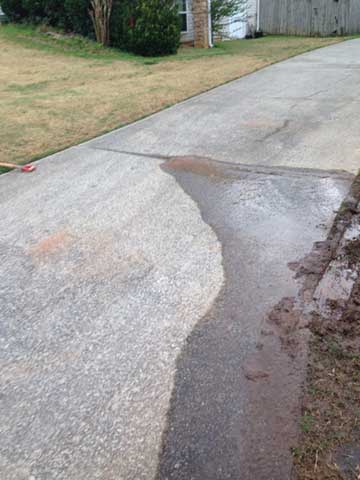
Water leaks under concrete are very tricky to find but very important to find. After all, you don’t want to start jack hammering through a concrete floor only to find out that the leak is 4 feet from the hole you just made!
So, what are the steps that you can take to find that water leak?
First – Confirm You Do Have A Leak
You may have already done this but just in case you did not, you want to first and foremost confirm that you do have a water leak on your property.
Here are the steps.
- Make sure there are no faucets running water or other water source that’s on in your home
- Check your water meter which is usually located in your front yard, sidewalk or easement.
- Lift the cover to the water meter box.
- If there is a cap on the meter go ahead and remove it to read the meter.
- Check your “leak indicator” which is usually a red triangle – if it’s moving your home is using water.
- If you don’t have a “leak indicator” check the sweep hand on the meter face. Mark where it currently is – come back and check in 20 minutes. If it’s moved then your home is using water.
If you have all the water in your home turned off and your water meter still shows that you are using water – then somewhere there is a leak.
If you’ve checked your toilets and you found that there are no leaks there – then the problem may be either in a water pipe in your walls or under your concrete slab.
How To Determine If The Leak Is Inside or Outside
Now that you’ve determined that you DO have a water leak, you will need to find out if the leak is inside your home or outside your home, underground.
Here’s what you can do.
- Find the main shutoff valve that’s in your home and shut it off. This valve is usually in the garage or the basement.
- After you’ve shut this off, check the water meter to see if the leak indicator or the sweep hand are moving which would indicate that water is still going through the meter.
- If the water meter shows no movement – then you know that the leak is inside the house.
- If the water meter shows movement – then you know that the leak is outside the house
If You Suspect A Leak Under Your Concrete Floor
The clues for locating a leak under your indoor concrete floor are not always indoors. Check the outside walls of your home for possible leaks located at the base of the house structure. Check for puddles, any signs of water where there shouldn’t be any.
Check for water inside your home coming out from the walls, underneath cabinets and/or coming up from any cracks in your ceramic tile or stone. If you find water then the next step is to check if the leaks are coming from areas that are close to water sources such as pipes under sinks, washing machine, etc. you will want to check those first for leaks.
If you find no leaks coming from these apparent sites – then there’s a high likelihood that you have a leak under the floor.
An easy trick if the water leak is hot water is to simply place your hand on the floor or walk barefoot. If you notice that one area of the floor is hotter or colder than another area – chances are you have a water leak under that floor. Normally, the hot water leak is very close to the “hot area” on your floor.
Ultrasonic leak detection
Here at Atlantis Plumbing, one of the tools we use is an ultrasonic leak detection tool. It’s an effective and non-invasive method of detecting water pipe leaks. It is the use of a listening device to amplify the sound of water or air escaping from a pipe, valve or fitting. Basically there is a head set, an amplifier and a mini-subwoofer that picks up the sound.
If you have any questions about water leaks under concrete or slabs or other plumbing issues, call Atlantis Plumbing today at 770-505-8570. We are available 24 hours a day, 7 days a week.